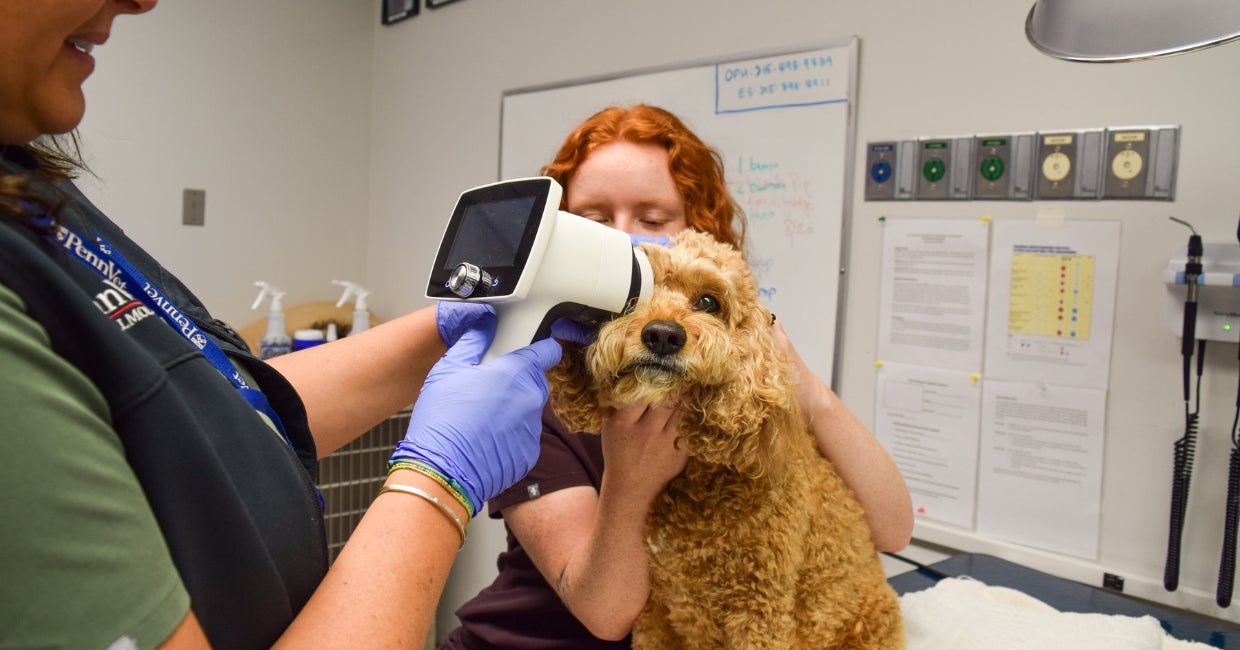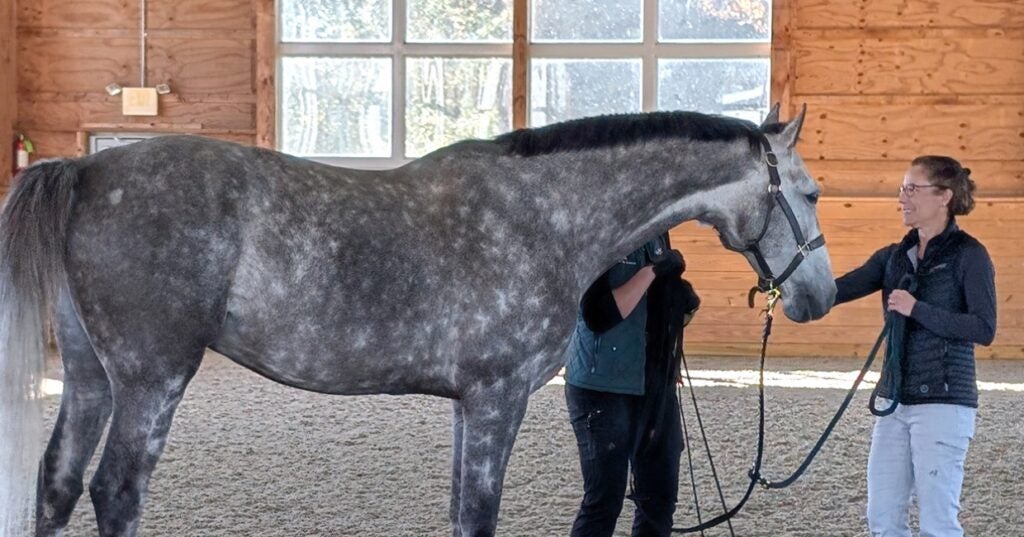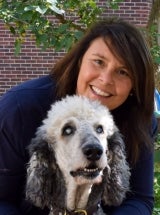A New Penn Vet Clinic Brings Support and Hope for Dogs with Retinal Disease

Zoey the cockapoo greeted life with tail-wagging joy. A mass of tawny curls, she loved everyone, and they loved her back. Her ever-growing Instagram account had over 3,000 followers.
But lately the furry internet star wasn’t the same. When night fell, the usually adventurous pup would cower beside her owner Adam Weitz and shake. Zoey seemed suddenly afraid of the dark.
So Weitz brought his Jersey girl to a veterinary ophthalmologist who gave him grim news – Zoey had progressive retinal atrophy (PRA), a category of genetic, blindness-causing diseases that have no cure. Zoey would be totally blind in two years, he was told.
Desperate for more information and maybe a little hope, the owner took Zoey to a new sub-specialty clinic at the University of Pennsylvania’s School of Veterinary Medicine (Penn Vet) dedicated to the study, diagnosis and monitoring of PRAs.
Zoey’s visit to Penn Vet’s Retinal Clinic did indeed give his owner more insight into PRAs. But more than that, it provided vital information researchers need to one day save other dogs’ sight.
That’s why clinic director Valérie Dufour, DVM, DECVO, Assistant Professor of Translational Ophthalmology, is encouraging more owners who suspect their dogs may have PRAs to come in for testing.
“Every piece of information we gather helps expand our understanding and informs us on better approaches to treating inherited retinal diseases,” said Dufour.
“The more patients we include, the stronger the evidence for the disease, and the greater the justification for developing treatments,” she said.
Launched last November, Penn Vet’s Retinal Clinic was established to support patients affected by PRA and to inform owners about the disease, its diagnosis and progression.
The Penn Vet clinic’s patients provide information about these diseases and their progression amid real-life conditions, rather than only in a controlled environment, according to Dufour.
Research has linked certain genetic mutations to PRAs – so far about 300 mutations in people and over 60 in dogs, she explained.
Some mutations have been linked to daytime blindness while others are associated with night blindness. Certain mutations are known to occur more often in particular breeds. One type of PRA tends to run in Labrador Retrievers, Miniature Poodles, and English Cocker Spaniels. Another tends to affect Standard Poodles. With the popularity of doodle mixes, more cases may emerge, Dufour said.
Progress in research and hope for treatments
Up to now, it has been believed that each mutation requires a specifically tailored treatment, but Dufour said Penn Vet’s Division of Experimental Retinal Therapies is actively exploring treatments with wider applications. The team’s efforts are yielding encouraging results that may soon help dogs and possibly humans, she said.
For now, “There’s still a lot of work to be done, but for some common mutations in dogs, we are hopeful to offer these treatment approaches within the next couple of years.”
When dogs come to the clinic, they receive both genetic testing and non-invasive examinations to assess the condition of their eyes. The tests are painless.
Evaluation includes having the dog navigate an obstacle course under both dim and bright lighting conditions. Dogs also undergo an electroretinogram to measure the retina’s electrical activity, plus optical coherence tomography testing where, under light sedation, specialized imaging allows high-definition views of the structural integrity of a dog’s retina.

examine Zoey’s eyes using Spectralis Optical Coherence Tomography.
Dufour also draws on her expertise acquired during more than a decade of examining dogs’ retinas for signs of PRAs. So far, a substantial percentage of the dogs who have come to the clinic with a previous PRA diagnosis don’t have it, she said, suggesting the need for updated training in identifying these conditions.
Cooper, a 5-year-old Standard Poodle from New York, was one of these incorrectly diagnosed dogs. His owners had brought him to a veterinary ophthalmologist after Cooper’s regular vet expressed concern about his right eye’s appearance.
The specialist, after some testing, concluded that Cooper was afflicted with PRA.
“She said, ‘I’m 98% sure. I wouldn’t recommend doing any tests, because it’s just going to put extra stress on him, and there’s no cure,’” recalled Ari Ahmed, one of Cooper’s owners.
Ahmed said she then searched the internet, looking for a university-based program that might offer an experimental treatment. She came upon the Penn Vet Retinal Clinic.
Ahmed said she and her husband were impressed by Dufour’s thoroughness and her team.
“They just took extra time. They really took care not just of Cooper but of us, too.”
After a long day of testing, and expecting “the worst,” they were amazed to learn Cooper didn’t have PRA after all, just a cataract. Of course, they are grateful Cooper’s sight isn’t at risk, but Ahmed said they are also glad for anything their experience can contribute toward finding a cure.
“We would do anything because it’s such a devastating diagnosis,” she said. “We wouldn’t want any other family to go through it.”
Carol Quercetti was braced for bad news when she brought Shadow, her and her mother’s Standard Poodle, to Dufour’s clinic. Shadow had begun acting like he was suddenly afraid of the dark, balking at taking his nightly walks and spooking at movements in the dimming light.

Instead, “We cried tears of joy.” Shadow did not have a PRA. The Pennsylvania resident was thrilled about that, but also glad for her family’s part in the clinic’s ongoing research.
“I understand the importance of research, and what it does for future patients,” she said. “It was definitely worth it.”
Susan Eichler is a devoted owner of English Labrador Retrievers. “I’ve had 12 dogs over the last 35 years. My dogs are my kids,” the Pennsylvania resident said.
Testing at Dufour’s clinic revealed that her dog Winston had a PRA caused by a gene mutation that had not previously been identified. Eichler then decided to bring in her English lab Angus, a relative of Winston, too.
There is a fee for the testing, but Eichler believes in its importance to her dogs’ breed as well as its potential to yield information helpful to canines and people afflicted by PRA.
“It has a way, way bigger reach than just my dog,” Eichler said.
Lessons in coping from experience, and Aspen
While Penn Vet’s Retinal Clinic cannot yet provide treatment for the dogs that test positive for PRAs, their owners get guidance on how to help their dogs cope with the disease, including information about alternatives such as nutritional supplements and products that may aid dogs navigate their environment. Owners also learn more about PRAs, including what to expect and how their four-legged companions can still live active lives.
In such matters, Dufour speaks from the heart. For her, the drive to find effective treatments is not only a researcher’s passion. Aspen, her own Standard Poodle, is blind due to a PRA. Her counsel to clients comes from personal experience.
That’s why Dufour advises owners to get their PRA dogs a companion canine. At home, she actually has three dogs – Theo, a Brittany Spaniel; Aspen, the poodle; and Raja, a Labrador Retriever who is a retired Seeing Eye dog.
“It’s like they know Aspen has an eye issue, especially the Seeing Eye dog. She’s very careful around him. She’s really leading the way,” Dufour said.
Aspen still has run-ins with the kitchen island. But on off-leash hikes, he’s learned that the feel of short grass under his paws means he is on the trail while tall grass means he has strayed off. “Then he just jumps back on the trail,” Dufour said.

“I can really relate to owners that I’m going through this every single day with my own dog, too,” said Dufour. “I know what I have in front of me, and I know the kind of information I can translate to them.”
Weitz, Zoey’s person, is pleased with his and Zoey’s experience with Penn Vet’s Retinal Clinic. He’s been giving the cockapoo, whose day vision is still good, nutritional supplements Dufour told him are widely recommended but aren’t a cure. He has seen some improvement.
“She seems a little bit more upbeat,” Weitz said, “and I’ve noticed she’s not shaking as much at nighttime.”
Weitz is also thinking about using Zoey’s Instagram account to share information about PRAs with other dog lovers. He figures they, too, may want to become more knowledgeable. Possibly they will get their dogs tested and contribute to the continuing research.
“It’s a terrible disease. If we can help someone else, that’s really great,” Weitz said. “Maybe we could further contribute to a cure for dogs and humans.”
For more information about Penn Vet’s retinal research, visit: Division of Experimental Retinal Therapies – University of Pennsylvania, School of Veterinary Medicine
Related News

Wild birds are driving the current U.S. bird flu outbreak (link is external)
Since late 2021, a panzootic, or “a pandemic in animals,” of highly pathogenic bird flu variant H5N1 has devastated wild birds, agriculture, and mammals.

Behind the Breakthroughs: Amy Johnson
Balancing clinical care with scientific inquiry, Penn Vet’s Amy Johnson leads efforts to decode the complexities of neurologic diseases in horses

In the Office with Donna Kelly, DVM, MASCP, DACPV, DACVPM
Donna Kelly, DVM, MASCP, DACPV, DACVPM, shares her New Bolton Center office with the campus’s microbiology reference library.
About Penn Vet
Ranked among the top ten veterinary schools worldwide, the University of Pennsylvania School of Veterinary Medicine (Penn Vet) is a global leader in veterinary education, research, and clinical care. Founded in 1884, Penn Vet is the first veterinary school developed in association with a medical school. The school is a proud member of the One Health initiative, linking human, animal, and environmental health.
Penn Vet serves a diverse population of animals at its two campuses, which include extensive diagnostic and research laboratories. Ryan Hospital in Philadelphia provides care for dogs, cats, and other domestic/companion animals, handling more than 30,000 patient visits a year. New Bolton Center, Penn Vet’s large-animal hospital on nearly 700 acres in rural Kennett Square, PA, cares for horses and livestock/farm animals. The hospital handles more than 6,300 patient visits a year, while our Field Services have gone out on more than 5,500 farm service calls, treating some 22,400 patients at local farms. In addition, New Bolton Center’s campus includes a swine center, working dairy, and poultry unit that provide valuable research for the agriculture industry.

